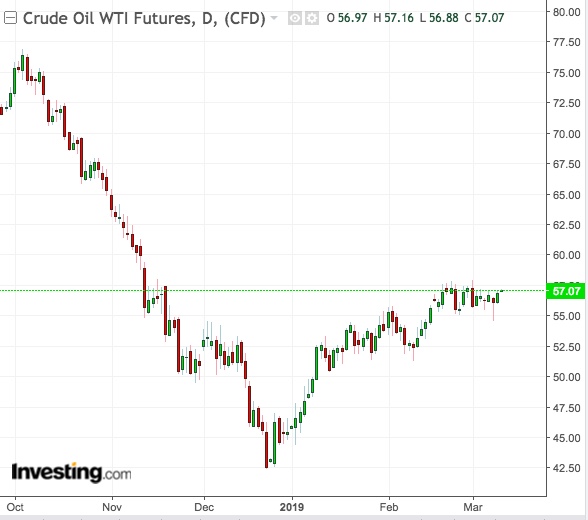Morgan Stanley sees Brent crude anchored at $65 per barrel over the long term while cross-town rival Goldman Sachs) expects a “fleeting” high of $75.
Whatever the forecast, the unprecedented depth of Saudi Arabia’s oil cuts now seems both a boon and bane for Riyadh, which is earning more for a barrel while risking precious market share to rivals in both the U.S. and Asia.
Of particular danger to the Kingdom: oil super majors like Exxon Mobil (NYSE:XOM) and Chevron (NYSE:CVX) usurping so much production capacity in U.S. shale oil in coming years that they become as influential as the Organization of the Petroleum Exporting Countries (OPEC) in shipping to the coveted Asian markets and dictating prices there.
A New 'OPEC' Of Super Majors?
That, in the words of John Kilduff, founding partner of New York energy hedge fund Again Capital, would present “a very precarious landscape for the future of Saudi oil” as well as “an incredible opportunity for the super majors to become an OPEC of their own kind.”
The world got a glimpse of what that future might look like after Exxon Mobil and Chevron recently announced plans to ramp up by almost another one million barrels per day their existing production at top U.S. shale basin Permian. Exxon Mobil went further to say that it expected double-digit returns on its Permian investments, even at low oil prices. For example, at $35 per barrel, Permian production will have an average return of more than 10%, it said.

Simply put, at the height of last year’s oil market collapse, when U.S. West Texas Intermediate crude fell to around $43 per barrel, Exxon Mobil was still making money from Permian oil—just when Saudi Arabia’s state-owned oil company Aramco and the national petroleum firms of many Middle East countries were starved of cash.
Big Oil Became Highly Profitable In Shale
A Bloomberg report on Monday validated the Exxon Mobil claim, saying Big Oil companies that suffered from the 2014 market crash had learned to survive in a lower-for-longer price era. They now make profits similar to the $100-per-barrel days, after sharing designs on almost everything from underwater valves to pumps to ensure standard and sustainable costs, and investing in economical U.S. shale patches rather than expensive far-flung projects around the world. The eight largest integrated oil and gas companies saw spending fall to $118 billion last year, down 45% from a pre-crisis peak of $215 billion in 2013.
The Bloomberg report also pointed out that lower costs didn’t mean weaker development or yields. Dominick Chirichella of the Energy Management Institute in New York remarked at the weekend that the U.S. oil rig count was down 48% from October 2014, while the country was producing 36% more crude. According to the U.S. Energy Information Administration, total crude output is at a record 12.2 million bpd now and is expected to reach 13 million bpd by end-2020.
By 2025, the U.S. will produce about 24 million bpd, more crude and energy liquids than Saudi Arabia and Russia output put together, forecasts show. This is partly due to a huge leap in drilling efficiency, one of the many evolving wonders of the shale industry, which isn’t as talked about as the record volumes of oil being produced.
Also missing from mainstream discussions on energy is the potential for Big Oil to become even bigger in U.S. shale by swallowing the smaller, independent drillers that make up the majority of the industry.
Said Kilduff:
“With the majors going into the Permian to do roll-outs, the independents there are getting squeezed by the banks, which want them to cough out more money or get out.”
“The most interesting aspect of shale were all the little, independent guys getting together to change the dynamics of the game. But if Big Oil buys them out, then Big Oil will control shale and ultimately prices of U.S. oil and wherever that oil goes.”
Saudis Face Threat To Market Share In Asia
That oil is Increasingly headed to Asia, the most protected Saudi market. While Riyadh has led the OPEC+ alliance of 25 oil producing countries in cutting production to boost oil prices by 25% this year, it’s common knowledge that those reductions are almost entirely for the U.S. market, which publishes the most transparent supply-demand data and is most influential in global oil pricing. Meanwhile, the Saudis have been faithfully fulfilling almost every barrel requested by Asian refineries, which can either take Ultra-Light Arab crude or Very Light U.S. Sweet crude.
To the consternation of the Saudis, S&P Global Platts reported in early February that U.S. crude exports to Asia were set to swell over March and April as a drop in freight rates made cargoes from America more competitive against barrels from Asia or the Middle East.
U.S. crude exports recently surpassed a record of 3.6 million bpd. While there’s no country breakdown on U.S. crude exports to Asia, demand for North American was growing as they consistently traded at a discount to comparable light and medium Persian Gulf grades, Platts reported.
U.S. Crude Exports Ramping
Of course, for U.S. crude exports to continue growing the way they’ve been, they’ll need enough pipelines to avert the transportation bottlenecks that have obstructed the transit of oil out of the Permian and other shale basins like the Bakken for years.
But even that seems to be coming through: Permian pipeline capacity is expected to triple to 9 million bpd by end-2021. Bakken, with 1.4 million bpd capacity as of November, could have a takeaway of 1.8 million by end of next year.
Kilduff concluded:
“The stars are aligning for the super majors to take control of shale and determine pricing for light crude in Asia, if not the world. They’ll be OPEC by a different name.”
